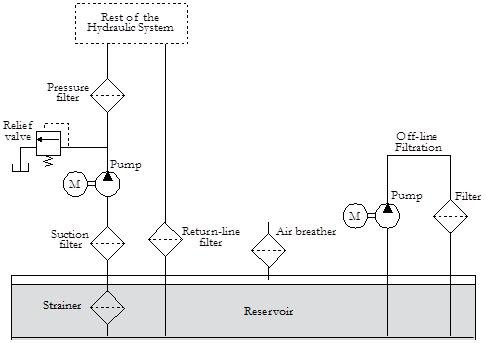Comparison of Hydraulic Filter Types and Locations
Published by Filter Element Store on Jun 25, 2019

It can be confusing determining which hydraulic filter housing goes where, and what hydraulic filter element belongs to your different hydraulic filter housings. Hopefully this guide will help clear up any confusion with proper locations and uses of the various types of hydraulic filters.
A Suction Strainer is located in the inlet of the pump. The strainer removes contamination from the reservoir fluid before it reaches the pump and the system components. These filters should be set up with an internal bypass valve to prevent starving the pump.
Advantages
- Last chance protection for pump
Disadvantages
- Must use relatively course media and/or large housing size, to keep pressure drop low due to pump inlet conditions
- Cost is moderate
- Does not protect downstream components from pump wear
A Pressure Filter is located downstream of the pump. It is exposed to full system pressure. The filter removes contamination generated or passed by the pump. A particularly contamination sensitive component may be protected by a “point of use filter” located immediately upstream of it.
Advantages
- Specific component protection
- Contributes to overall system cleanliness
- Catches wear debris from pump
Disadvantages
- Housing is relatively expensive because it must handle full system pressure
- Does not catch wear debris from downstream working components
A Return Line Filter is located downstream of the pump and system components and upstream of the system reservoir. The return filter removes contamination generated or ingested by the pump and components, before the fluid returns to the reservoir.
Advantages
- Catches wear debris from components before it enters the reservoir
- Lower pressure ratings result in lower cost
- May be in-line or in-tank for easier installations
Disadvantages
- No protection from pump generated contamination
- Return line flow surges may reduce filter performance
- No direct component protection
An Off-Line Filter is located in a separate loop connected to the reservoir and has its own source of power. The Off-Line Filter operates independently of the main hydraulic system cleaning the fluid in the reservoir only.
If you have a question about some of these hydraulic filter tips, or you need further assistance, please contact us for help with your Hydraulic Filter Element application.
